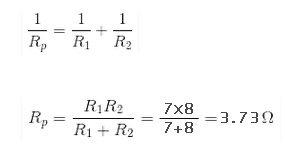
Resistance is the measure of opposition applied by any object to the flow of electric current. A resistor is an electronic constituent that is used in the circuit with the purpose of offering that specific amount of resistance.
The resistance of any object is computed making use of the formula:

In this case,
v = Voltage across its ends
I = Current flowing through it
If the resistance’s are linked in series, the series resistance is articulated as-

If resistance are connected in parallel, the parallel resistance is given by

Where, R1, R2, R3 …… Rn are the given resistors. Resistance is measured in ohms (Ω).
Resistance Formula is used to compute the resistance across any given number of resistors in the circuit. It can similarly be made use of to compute the resistance in any given object.
Check the list of all Physics Formulas here. For Biology, Physics, Maths, English, GK etc please check respective sections of CheckAll.in. You can now subscribe here for free, to get notification regarding new posts.
Here are some exercise problems with solutions for you.
Solved Problems using Resistance Formula
Problem 1: Compute the resistance offered by the body if 5mA of current is flowing having a potential difference of 5V?
Answer:
Known:
I (Current) = 5mA,
V (Potential difference) = 5 V
The resistance is given by R=(V/I)=5/(5×10-3)=1000 Ω
Problem 2: Compute the resistance if 7 Ω and 8 Ω are connected in parallel.
Answer:
Known:
Resistance
R1 = 7 Ω,
R2 = 8 Ω
The parallel resistance is articulated as

Problem 3: An emf source of 5.0V is connected to a purely resistive lamp and a current of 1.0 amperes flows. All the wires are resistance-free. What is the resistance of the lamp?
Answer:
The gain of potential energy occurs as a charge passes through the battery, that is, it gains a potential of =5.0V. No energy is lost to the wires, since they are assumed to be resistance-free. By conservation of energy, the potential that was gained (i.e. =V=5.0V) must be lost in the resistor. So, by Ohm’s Law:
V = I R
R=V/I
R = 5/1 = 5Ω